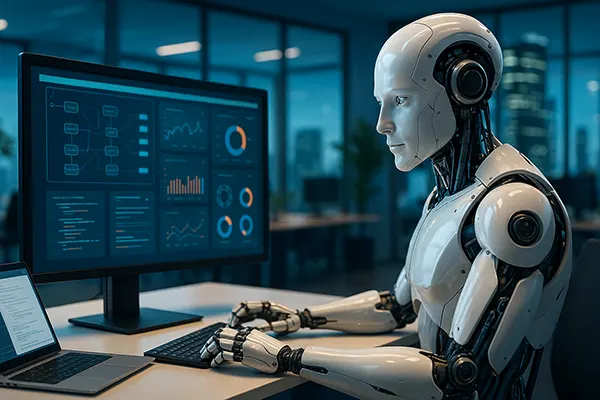
Next-Generation AI Agents: Integrating Autonomous Models into Workflows
Artificial intelligence is entering a new era. The emergence of autonomous AI agents—capable of making independent decisions and executing complex tasks—marks a pivotal shift in how businesses and professionals interact with technology. Unlike traditional models that require constant prompting, these agents act proactively, adapt to dynamic environments, and integrate seamlessly with operational systems. In this article, we explore the real-world applications of next-gen AI agents, the technical backbone supporting their autonomy, and the impact they are already having across industries as of June 2025.
The Rise of Autonomous AI in Professional Environments
As of mid-2025, the global trend is moving toward embedding autonomous AI agents directly into core workflows. These agents are not just tools for automation—they function as intelligent collaborators capable of reasoning, planning, and responding to new inputs in real-time. Tech leaders like OpenAI, Microsoft, and Cohere have introduced frameworks that allow organisations to customise and deploy agents tailored to specific operational needs.
In finance, AI agents are now used for regulatory compliance monitoring, detecting anomalies in transactions, and proactively updating reports based on real-time data feeds. In logistics, agents autonomously manage inventory reordering, fleet dispatch optimisation, and supply chain coordination. The integration isn’t experimental anymore—it’s becoming standard practice for data-heavy enterprises aiming for speed and efficiency.
The key factor driving this growth is the increasing accessibility of APIs and SDKs that support agentic architecture. Developers and companies can now deploy scalable agents using frameworks such as LangChain or Microsoft’s AutoGen Studio, reducing both cost and implementation time. These systems support memory, recursive logic, and dynamic goal setting, offering a robust foundation for autonomous operations.
Capabilities That Differentiate Modern AI Agents
Unlike previous AI iterations, next-gen agents can operate without direct supervision for extended periods. They maintain memory across sessions, prioritise tasks based on changing objectives, and even troubleshoot their own limitations. This is achieved through multi-agent cooperation frameworks where agents consult one another to validate actions or distribute workload.
For instance, in software engineering, AI developer agents can now write code, debug errors, and even conduct code reviews with minimal human input. These tasks were previously segmented among different tools or required constant oversight. Now, a single orchestrated agent system can cover the full lifecycle of a task from planning to execution.
Such agents are also capable of grounding their decisions in real data. For example, legal firms use them to scan databases of case law and propose strategies based on precedent. This capacity to synthesise, evaluate, and act on information autonomously sets a new benchmark in AI application maturity.
Real-World Deployment and Integration Models
Companies are moving quickly to incorporate autonomous agents across verticals. A significant example is the healthcare industry, where AI agents are being integrated into patient monitoring systems. These agents analyse patient data in real time, flag early signs of deterioration, and initiate alerts or treatment adjustments—all without requiring a clinician to intervene initially.
In e-commerce, AI agents handle dynamic pricing, customer support, and fraud detection simultaneously. With access to live market trends, transaction history, and customer profiles, they can modify strategies minute-by-minute. This form of proactive interaction gives businesses a competitive edge by ensuring customer satisfaction and operational fluidity.
Implementation is typically achieved through hybrid architecture—combining cloud-based LLMs with on-premise microservices that handle domain-specific logic. This model allows sensitive data to stay local while tapping into powerful generative reasoning hosted remotely. The flexibility of this structure has made it the preferred route for firms concerned with data security and compliance.
Security and Ethical Challenges
Despite their advantages, autonomous agents present notable challenges. Security is a primary concern, particularly in sectors such as banking or defence. Ensuring agents do not exceed their operational boundaries or fall victim to adversarial attacks requires rigorous sandboxing, real-time monitoring, and controlled feedback loops.
Ethical governance is another critical factor. As agents begin making decisions that affect customers, employees, or patients, organisations must develop clear accountability protocols. This includes audit trails, human-in-the-loop mechanisms, and explainability features that justify each decision taken by the agent.
Regulatory bodies, including the European Commission and U.S. Federal Trade Commission, are already drafting standards that define permissible use cases, consent frameworks, and data handling policies. These guidelines will shape how autonomous agents are trained, deployed, and supervised in the coming years.

The Future of Workflow Automation Through AI Agents
Looking forward, the capabilities of AI agents will continue to expand as models become more specialised. Domain-specific agents—trained on vertical datasets such as legal documentation, medical imaging, or engineering schematics—will outperform general-purpose systems in precision tasks. This verticalisation will be essential in regulated or technical fields.
Another transformative trend is the development of lifelong learning agents. These systems continuously absorb new data from their environments, adapting without needing retraining. This means they evolve with the business, becoming more aligned with organisational goals over time. Early prototypes are already in pilot use within R&D labs and innovation hubs.
As the lines blur between AI-driven automation and human decision-making, the role of agents is likely to shift from executors to strategic advisors. Rather than simply performing predefined tasks, agents will recommend courses of action, simulate outcomes, and support high-level decision-making in executive contexts.
Preparing Organisations for Intelligent Autonomy
To capitalise on the rise of AI agents, organisations must rethink their digital infrastructure. This includes implementing APIs that enable agent integration, centralised data lakes that agents can draw upon, and orchestration layers that manage agent collaboration and task handoff.
Training internal teams to understand and work alongside autonomous systems will also be crucial. This doesn’t just mean data scientists—it involves operational managers, security teams, and executive leadership who must align strategy with technological capability.
Ultimately, companies that embrace agent-based operations today will be positioned as leaders in the intelligent automation economy of tomorrow. Their workflows will be faster, more adaptive, and strategically informed in ways that were previously impossible with static systems.
Popular articles
-
 Why Modern Technologies Are Becoming More ...
Why Modern Technologies Are Becoming More ...Modern technologies are developing at a pace that few users can fully …
Learn more -
 Next-Generation Home Batteries: Hybrid Ene...
Next-Generation Home Batteries: Hybrid Ene...Hybrid home batteries have become a practical foundation for residential energy autonomy …
Learn more -
 How Artificial Intelligence Transforms Hom...
How Artificial Intelligence Transforms Hom...By 2025, artificial intelligence has become a central component of modern home …
Learn more
